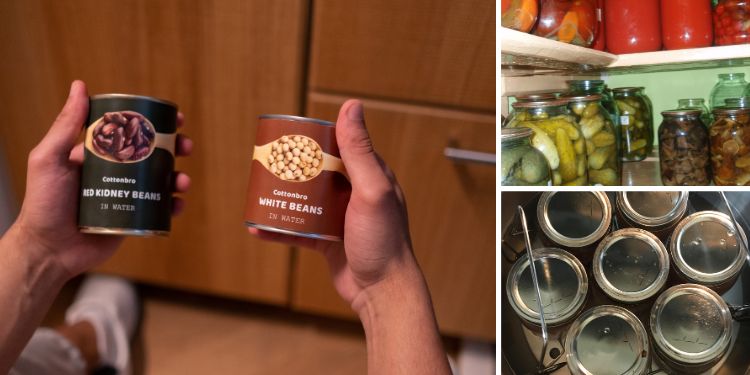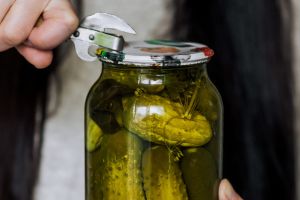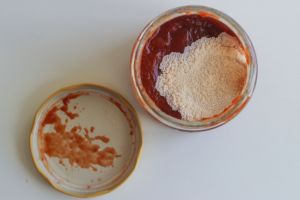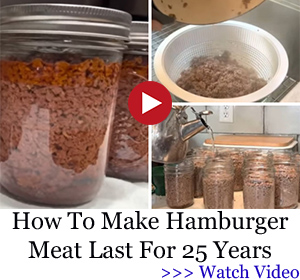If You Notice This, Stop Eating Your Canned Food

Canned food is a lifesaver when it comes to long-term storage.
Regardless of whether you’re prepping for an emergency, stocking your pantry, or just want to stretch out your groceries a bit, canned foods can last for a long time and are incredibly convenient to prepare and eat.
But here’s the thing: just because food is sealed in a can doesn’t mean it’s safe forever. In fact, canned food can go bad.
The key to staying safe is knowing what to look for. There are some clear red flags that tell you when it’s time to toss that can instead of opening it.
If you notice any of these signs we’re about to cover, you’ll want to throw your canned food out.
Bulging or Popped Lids – The Biggest Red Flag of All
One of the most obvious and dangerous signs that your canned food has gone bad is a bulging or popped lid. This is the biggest red flag you can spot, and if you see it, it’s time to toss that can immediately (as in don’t even think about opening it).
A bulging lid specifically means there’s likely gas buildup inside the can, which is often caused by bacteria growing in the food. When bacteria like Clostridium botulinum multiply, they produce gasses that create pressure inside the can.
This can cause the lid to swell or even pop open. It’s also important to pay attention when you open the can. If you hear a loud “hiss” or notice air being released (almost like opening a soda), that’s another bad sign.
Did you know that many store-bought canned foods are loaded with unnatural preservatives and chemicals to extend their shelf life? These additives can compromise your health over time.
Canning your own food is a much better option—but what if you could take it a step further? Learn here hundreds of forgotten techniques and recipes for creating shelf-stable, chemical-free meals, that last for decades without relying on modern additives or fragile supply chains. It’s the ultimate guide for anyone serious about being prepared for a future where store shelves might be empty.
Leaking or Rusty Can – A Clear Sign of Contamination
 A leaking or rusty can is another clear sign that your canned food is no longer safe to eat. Leaks or rust might seem like minor cosmetic issues, but they can mean that the can has been compromised.
A leaking or rusty can is another clear sign that your canned food is no longer safe to eat. Leaks or rust might seem like minor cosmetic issues, but they can mean that the can has been compromised.
Even a small leak means that the seal has been broken, and when air gets inside, it allows bacteria to grow.
Rust is just as concerning. While a little surface rust might not seem like a big deal, heavy rust can weaken the can and create tiny holes or cracks that aren’t always visible. Rust is more common in cans stored in damp or humid areas.
Foul Smells – Avoid At All Costs
Foul smells are never a good thing when it comes to food. As in literally never. The beauty of this warning sign is that your sense of smell is pretty good at detecting when food has gone bad.
Spoiled canned food can give off a variety of odors, from sour and musty to metallic or just a plain rotten stench. These smells usually indicate that bacteria or mold has been growing inside the can, which will lead to serious foodborne illnesses if you consume the fod inside. Even if the food looks okay at first glance, a bad odor is enough reason to throw it out. Remember, you can always trust your nose!
While canned food is great for emergencies, nothing beats having a steady supply of fresh, homegrown food. That’s why I turn to The Self-Sufficient Backyard. This book is packed with practical advice for creating a self-sustaining garden that can keep your family well-fed year-round. Whether you’re a seasoned gardener or just starting out, it covers everything you need to know—how to grow, harvest, maintain, and preserve your food supply—even in a small space!
Unusual Colors – It’s Spoiled
 If the food inside the can looks discolored, has dark spots, or simply doesn’t look the way it should, it’s a major indicator that it has spoiled and should not be eaten.
If the food inside the can looks discolored, has dark spots, or simply doesn’t look the way it should, it’s a major indicator that it has spoiled and should not be eaten.
Fresh canned food typically maintains its original color, or something close to it, even after being stored for very long periods of time.
But when spoilage occurs, the food can take on strange, unnatural hues. For example, vegetables may appear faded, meats can look gray or brown, and fruits might develop dark or black spots.
Another telltale sign of spoilage is the presence of mold, which may appear as white, green, or black patches on the surface of the food. Color changes like this often result from exposure to air or bacterial contamination, both of which can happen when the can’s seal is compromised.
Dented Cans – Proceed with Caution
Dented cans are a tricky subject. While not every dented can is dangerous, some dents can seriously compromise the safety of the food inside, so it’s important to proceed with caution.
When inspecting a dented can, pay close attention to where the dent is located. If the dent occurs near the seams or the lid of the can, there’s a risk that the seal has been broken, which can let in air and bacteria. Small, shallow dents on the body of the can are usually less of a concern, however, and you’ll want to look for other signs of spoilage or contamination like we’ve covered above.
Another thing to look out for is whether the can feels soft or has any movement in the dented area. If the dent is deep enough that you can press on it and it moves or flexes, that’s a bad sign. Cans are designed to be rigid, and any structural weakness could mean the can is no longer sealed the way it should be.
When it comes to canned food, safety should always come first. While cans are designed to preserve food for long periods, they aren’t invincible, and knowing the signs of spoilage like we’ve covered above is crucial to avoid serious health risks.
You may also like:
 EMP-Proofing Myths No One Ever Told You
EMP-Proofing Myths No One Ever Told You
What Happens If You Pour Salt Into a Cabbage (Video)
7 Guns Preppers Need to Buy Before the Upcoming Gun Ban
10 Household Items You Need to Stock Up On Before the Upcoming Great Depression
Read the full article here







